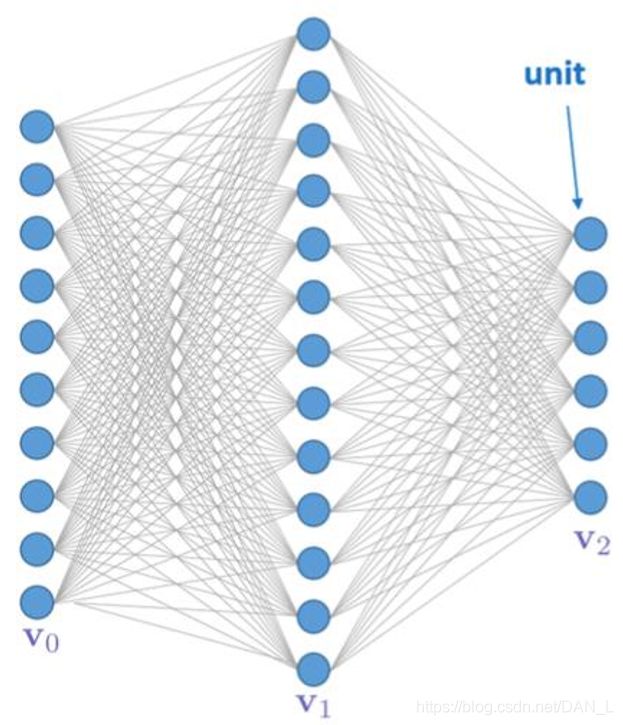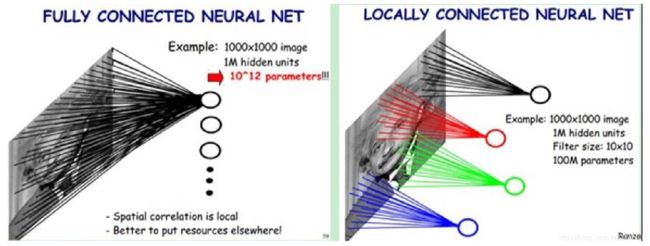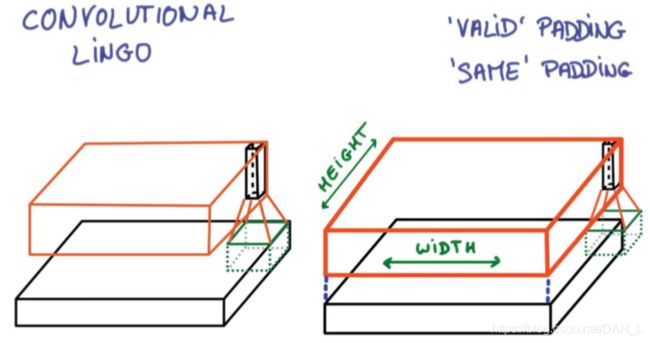卷积神经网络
一、传统神经网络存在的问题
(一)权值太多,计算量太大
(二)权值太多,需要大量样本进行训练

二、局部感受野
1962年哈佛医学院神经生理学家Hubel和Wiesel通过对猫视觉皮层细胞的研究,提出了感受野 (receptive field)的概念,1984年日本学者Fukushima基于感受野概念提出的神经认知机 (neocognitron)可以看作是卷积神经网络的第一个实现网络,也是感受野概念在人工神经网络领 域的首次应用。
三、卷积神经网络CNN
CNN通过感受野和权值共享减少了神经网络需要训练的参数个数。

(一)卷积

(二)池化

(三)对于卷积操作
1、SAME PADDING
给平面外部补0 ,卷积窗口采样后得到一个跟原来平面大小相同的平面。
2、VALID PADDING
不会超出平面外部 ,卷积窗口采样后得到一个比原来平面小的平面。

(四)对于池化操作
1、SAME PADDING:可能会给平面外部补0
2、VALID PADDING:不会超出平面外部

四、代码实现
import tensorflow as tf
from tensorflow.examples.tutorials.mnist import input_data
mnist = input_data.read_data_sets(‘MNIST_data’,one_hot=True)
#每个批次的大小
batch_size = 100
#计算一共有多少个批次
n_batch = mnist.train.num_examples // batch_size
#初始化权值
def weight_variable(shape):
initial = tf.truncated_normal(shape,stddev=0.1)#生成一个截断的正态分布
return tf.Variable(initial)
#初始化偏置
def bias_variable(shape):
initial = tf.constant(0.1,shape=shape)
return tf.Variable(initial)
#卷积层
def conv2d(x,w):
return tf.nn.conv2d(x,w,strides=[1,1,1,1],padding=‘SAME’)
#池化层
def max_pool_2x2(x):
return tf.nn.max_pool(x,ksize=[1,2,2,1],strides=[1,2,2,1],padding=‘SAME’)
#定义两个placeholder
x = tf.placeholder(tf.float32,[None,784])#28*28
y = tf.placeholder(tf.float32,[None,10])
#改变x的格式转为4D的向量[batch, in_heigh, in_width, in_channels]
x_image = tf.reshape(x,[-1,28,28,1])
#初始化第一个卷积层的权值和偏置
w_conv1 = weight_variable([5,5,1,32])#5*5的采样窗口,32个卷积核从1个平面抽取特征
b_conv1 = bias_variable([32])#每一个卷积核一个偏置值
#把x_image和权值向量进行卷积,再加上偏置值,然后应用于relu激活函数
h_conv1 = tf.nn.relu(conv2d(x_image,w_conv1) + b_conv1)
h_pool1 = max_pool_2x2(h_conv1)#进行max-pooling
#初始化第二个卷积层的权值和偏置
w_conv2 = weight_variable([5,5,32,64])#5*5的采样窗口,64个卷积核从32个平面抽取特征
b_conv2 = bias_variable([64])#每一个卷积核一个偏置值
#把h_pool1和权值向量进行卷积,再加上偏置值,然后应用于relu激活函数
h_conv2 = tf.nn.relu(conv2d(h_pool1,w_conv2) + b_conv2)
h_pool2 = max_pool_2x2(h_conv2)
#初始化第一个全连接层的权值
w_fcl = weight_variable([7764,1024])#上一层有7764个神经元,全连接层有1024个神经元
b_fcl = bias_variable([1024])
#把池化层2的输出扁平化为1维
h_pool2_flat = tf.reshape(h_pool2,[-1,7764])
#求第一个全连接层的输出
h_fcl = tf.nn.relu(tf.matmul(h_pool2_flat,w_fcl) + b_fcl)
#keep_prob用来表示神经元的输出概率
keep_prob = tf.placeholder(tf.float32)
h_fcl_drop = tf.nn.dropout(h_fcl,keep_prob)
#初始化第二个全连接层
w_fc2 = weight_variable([1024,10])
b_fc2 = bias_variable([10])
#计算输出
prediction = tf.nn.softmax(tf.matmul(h_fcl_drop,w_fc2) + b_fc2)
#交叉熵代价函数
cross_entropy = tf.reduce_mean(tf.nn.softmax_cross_entropy_with_logits(labels=y,logits=prediction))
#使用AdamOptimizer进行优化
train_step = tf.train.AdamOptimizer(1e-4).minimize(cross_entropy)
#结果存放在一个布尔列表中
correct_prediction = tf.equal(tf.argmax(prediction,1),tf.argmax(y,1))
#求准确率
accuracy = tf.reduce_mean(tf.cast(correct_prediction,tf.float32))
with tf.Session() as sess:
sess.run(tf.global_variables_initializer())
for epoch in range(21):
for batch in range(n_batch):
batch_xs,batch_ys = mnist.train.next_batch(batch_size)
sess.run(train_step,feed_dict={x:batch_xs,y:batch_ys,keep_prob:0.7})
acc = sess.run(accuracy,feed_dict={x:mnist.test.images,y:mnist.test.labels,keep_prob:1.0})
print('Iter' + str(epoch) + ',Testing Accuracy =' + str(acc))
返回值为
Iter0,Testing Accuracy =0.8648
Iter1,Testing Accuracy =0.8768
Iter2,Testing Accuracy =0.9578
Iter3,Testing Accuracy =0.9766
Iter4,Testing Accuracy =0.9825
Iter5,Testing Accuracy =0.9848
Iter6,Testing Accuracy =0.9871
Iter7,Testing Accuracy =0.9874
Iter8,Testing Accuracy =0.9891
Iter9,Testing Accuracy =0.9881
Iter10,Testing Accuracy =0.9891
Iter11,Testing Accuracy =0.9896
Iter12,Testing Accuracy =0.9913
Iter13,Testing Accuracy =0.9906
Iter14,Testing Accuracy =0.9915
Iter15,Testing Accuracy =0.9898
Iter16,Testing Accuracy =0.9913
Iter17,Testing Accuracy =0.9898
Iter18,Testing Accuracy =0.9907
Iter19,Testing Accuracy =0.9924
Iter20,Testing Accuracy =0.9916